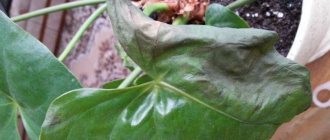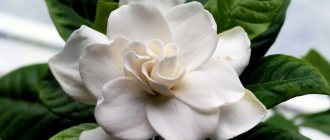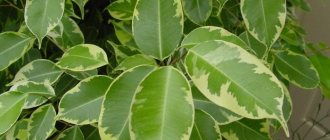Botanical description
Anthurium orange is a perennial and fast-growing plant. The height of the flower can be from 50 cm to 1 m (depending on the variety), and has an aerial root system.
The color range of the bedspread varies from light orange to a more saturated orange hue; the bract, like the leaves of the plant, can have a glossy or matte surface. Leaves are round or heart-shaped.
Today there are many bred hybrids of this species.
What else is it called?
“Male happiness” is the general name for anthuriums, regardless of the variety or color of the cover, but orange anthurium has its own. “Fire tongue” is what people call it because of the similarity of the orange blanket with tongues of flame.
Latin name
The name of the anthurium flower comes from two Latin words “Anthos” - flower and “Oura” - tail.
The name of orange anthurium depends on the variety, for example: “Anthurium scherzerianum” - Scherzer’s anthurium or “Anthurium Andraeanum” - Andre’s anthurium.
Appearance
The home flower Anthurium orange can reach 80 cm in height; lovers of indoor plants choose it for its beautiful flower, which is a yellow to red spadix (depending on the species) and a spathe around it.
The blanket can be a single color orange, but sometimes there are two-tone types (the color of the sail smoothly transitions from one shade to another). The plant has a pleasant and unobtrusive smell.
Two-color
Anthuriums of two-color hybrid varieties are united by the common name Obake (translated from Japanese as “changeable”) and amaze with unusual combinations of shades on large bracts.
Rainbow Obake
This variety has a more complex coloring, which includes not even two shades, but much more. On the white background of the bract, dark pink veins and a more delicate coating are visible, and its base is painted in a light green tone.
Mauna Loa Obake
A characteristic feature of the plant is a light, almost white spot in the center of the cover and a soft green surrounding. The veins have a pink tint, and the flower's ear is white and yellow .
Watermelon Obake
The inflorescences of this variety are distinguished by a pink, juicy center and green edges.
The exotic plant anthurium, thanks to its extraordinary, very impressive appearance and huge variety of colors, has become a recognized favorite among florists, phytodesigners and decorators. It is ideal for bouquets and compositions, for decorating residential and office interior spaces and decorating various events.
Varieties: description and photo
There are several popular types of this flower that are well suited for home gardening and greenhouses. These varieties include:
- Andre;
- Scherzer.
Each variety has subspecies, which we will consider further, starting with the Andre variety.
Baby Orange
“Orange Baby”, a small bush with a yellow straight ear and an orange leathery spathe with a green border. The Baby Orange variety is easy to care for and grows well in shady places. The flower is suitable for cutting.
Champion
Champion orange is a medium-sized plant with green or yellow inflorescences and orange-red glossy bracts. It also has large oblong leaves; at the end of flowering, the spathe turns green and turns into a leaf. The plant loves diffused light, without direct sunlight. After cutting, the flower remains fresh for up to 3 weeks.
Amaretti
The Scherzer anthurium variety includes one of the popular species among gardeners - “Amaretti”. This plant has a yellow-orange cob curled like a pig's tail and a variegated orange-scarlet sail. It takes root well at home and produces flowers almost immediately.
Anthurium varieties Andre and Scherzer by color
There are a huge number of hybrid forms of “male happiness” and there are more and more of them every day. We present the most popular and affordable Andre and Scherzer anthurium varieties with names and photos, and also indicate less common forms.
White
The most popular white varieties: “Champion White” (White champion, white champion), “Sumi” (Sumi). White and pink: “Princess Amalia Elegance” (Princess Amalia Elegance).
"Champion White" (White champion, white champion), "Sumi" (Sumi) and "Princess Amalia Elegance" (Princess Amalia Elegance).
Red
The most famous red varieties: “Dakota” (Dakota), “Sierra Magic” (Sierra Magic), “Turenza (Perfectred)” (Turenza).
Red-green: Anthurium adrianum 'Baby Boom'.
Others: Almera, Bugatti Veyron, Champion Red, Dynamite Red, Red King, Royal Champion" (Royal champion), "Success Red" (Success ed).
"Dakota" (Dakota), "Sierra Magic" (Sierra Magic), "Turenza (Perfect red)" (Turenza) and "Baby Boom" (Baby Boomer).
Orange
Orange variety: "Picasso Orange" (Picasso orange).
Orange-red forms: "Baby Orange", "Madural Orange", and also "Princess Orange".
"Picasso Orange", "Baby Orange" and "Madural Orange"
Pink
Pink varieties: “Joli” (Jolie), “Lady Love” (Lady Love), “Pink Alabama” (Pink Alabama) and “Pink Champion” (Pink Champion, pink).
Other forms: “Picasso Pink” (Picasso pink, pink), “Pink King” (Pink King), “Pink Queen”.
"Joli" (Jolie), "Pink Alabama" (Pink Alabama) and "Pink Champion" (Pink Champion, pink).
Pink-green: “Fantasy Love” (Fantasy Love), “Leganza” (Leganza), “Pandola” (Pandola).
“Fantasy Love” (Fantasy Love), “Leganza” (Leganza) and “Pandola” (Pandola).
Violet (lilac or lilac)
Purple varieties: Cavalli Purple, Fiorino and Utah. Also an interesting option: “Picasso Purple” (Picasso purple).
"Cavalli Purple" (Cavalli Purple), "Fiorino" (Fiorino) and "Utah" (Utah).
Blue and blue anthurium: painted or not?
“Male happiness” does not have a gene for blue or blue color (pigment), therefore, it is impossible to breed a variety with a similar color of the bedspread. According to specialists from the Faculty of Biology of Moscow State University, the samples presented today are flowers painted using special ink injections into the peduncle.
For example, the Dutch company offers the blue anthurium variety “Princess Alexia Blue” and the bright yellow flower “Princess Alexia Yellow” using this technology. Famous blue variety: "Picasso Blue" (Picasso blue (blue)).
"Picasso Blue" (Picasso blue (blue)) and "Princess Alexia Blue" (Princess Alexia blue).
Yellow
“Picasso Yellow” (Picasso yellow), “Princess Alexia Yellow” (Princess Alexia yellow), “Vanilla” (Vanilla, vanilla).
“Picasso Yellow” (Picasso yellow), “Princess Alexia Yellow” (Princess Alexia yellow) and “Vanilla” (Vanilla, vanilla).
Green
"Baby Green", "Green King", "Midori", "Picasso Green".
"Baby Green", "Green King", "Midori" and "Picasso Green".
Black (chocolate)
The most popular black varieties: “BlackBeauty” (Black Beauty, black beauty), “Black Queen” (Black Queen, black queen) and “Otazu” (Otazu).
Rarer varieties: “BlackDragon” (Black Dragon, black dragon), “BlackLove” (Black Love, black love).
“Black Beauty” (Black beauty, black beauty), “Black Queen” (Black queen, black queen) and “Otazu” (Otazu).
Home care
“Male Happiness” is not an ordinary flower, so it requires special attention. Let's consider all the rules for caring for this flower.
Temperature
Orange anthurium is a tropical heat-loving plant; the optimal temperature in summer is from 20 to 28 degrees, in winter from 15 to 20.
Watering
To water “male happiness”, use boiled, settled, warm water with a temperature of 20 degrees. Watering should be done only after the soil in the pot has dried out by at least a third. After watering, drain excess water from the tray and wipe it dry until next time.
Light
Lighting plays an important role in the life of any plant; anthurium is no exception; it loves soft, diffused light.
Advice! In winter, the plant can be placed in partial shade to rest from flowering and recuperate.
Priming
Ordinary soil is not suitable for anthurium, so the soil is made using different components, such as:
- Coarse soil.
- Chopped moss.
- Light turf soil.
Mix all components in a ratio of 2:1:1; tree bark or chopped coconut coir can be used as a base. You can also make a special moisture-resistant substrate, which includes the following components:
- Pumice fraction no more than 3 cm.
- Pine bark.
- Peat.
- Horse dung.
They are mixed in proportions 2:2:1:1, and pumice is replaced with inexpensive expanded clay.
Trimming
The reasons for pruning a flower are different; basically, this manipulation is performed on an adult plant. Let's look at the main ones:
- Dying of the lower leaves and exposure of the trunk.
- The transformation of a flower into a bush with small leaves and flowers, and subsequently a complete cessation of flowering occurs.
The circumcision procedure is performed as follows:
- Cut off old dried leaves and stems with pruning shears.
- Process the cuts.
- Next, I completely spray the plant with a spray bottle.
- Spraying is carried out every day until the wounds of the flower are completely healed.
Top dressing
Not all flower growers know exactly what to feed orange anthurium with, so after some time the plant stops blooming. To prevent this from happening, you need to choose the following fertilizers:
- Mineral.
- Organic.
- Universal.
The most effective organic fertilizers are:
- Mullein.
- Humus.
- Bird droppings.
But when choosing mineral fertilizers, many gardeners do not know what to choose for orange anthurium. The most suitable fertilizers for this tropical plant are:
- Uniflor Bud.
- Azalea.
- Kemira Lux.
For reference! It is not enough to know what fertilizers need to be used; you need to choose the right dosage; the instructions on the package can help with this. Young plants are fed with half the full dosage.
There are also fertilizers that you can make at home from natural products with your own hands. For example:
- Dry yeast. It is necessary to make a solution of 0.5 tsp. yeast, 2 tbsp. sugar and 5 l. water, the mixture is infused for a day, after which it is diluted with water 5:1 and watered at the root.
- A solution of wood ash is made in a similar way: 1 tbsp. raw materials per liter of water, the plant is fed with this mixture twice a month.
Pot
You need to be careful when choosing the shape, size and material for the pot. The container should not be high, but wide, since the roots of the anthurium grow not downward, but outward.
The diameter of a pot for a young flower can be 1-2 cm, every 2-3 years the capacity needs to be doubled. It is best to choose a pot made of plastic or glass vases, because clay products quickly evaporate moisture and hold a high temperature for a long time, which harms the flower.
Transfer
The correct replanting process contributes to the development of the plant, and in order for this to go smoothly and quickly, you need to use step-by-step instructions:
- First of all, you need to choose a suitable pot and soil.
- Next, you need to prepare the tools and supplies necessary for transplantation.
- We prepare the plant for transplantation by watering it well with water so that the earthen lump is completely soaked.
- We carefully examine the roots, remove the rotten ones and treat them with charcoal or insecticides.
- Next, we lay out drainage at the bottom of the pot and sprinkle it with soil, then install the shoot and sprinkle the roots with soil.
Attention! Anthurium juice causes stomach upset and skin irritation, so it should be kept away from children and pets, and all work should be done with gloves.
Wintering
As a rule, in winter, anthurium is moved to partial shade so that the plant can rest before flowering again. The flower does not need feeding during this period; it is watered once a week.
Reproduction
The plant can be propagated in different ways, such as:
- Dividing a large bush.
- Rooting side shoots.
- Growing from a root.
- By cuttings.
- Leaf propagation.
- Germination of seeds.
Diseases and pests
There are different types of pests that spoil indoor flowers, and orange anthurium is no exception. Parasites that can harm “male happiness”:
- aphid;
- spider mite;
- scale insect;
- thrips;
- whitefly
But not only pests can ruin a plant, but also diseases, for example:
- lack of flowering;
- spots on leaves;
- drying of a flower;
- enations;
- smallpox;
- anthractosis;
- fusarium;
- gray rot;
- root rot;
- powdery mildew and much more.
Reproduction
In the room, anthuriums can be propagated by seeds and also vegetatively.
The most labor-intensive and time-consuming method of propagation is seed. However, thanks to it you can get new interesting hybrids of varieties. Anthurium seeds can be purchased at flower shops or you can get your own. In the latter case, the plant will have to be pollinated manually, transferring pollen from flower to flower with a cotton swab or brush. After pollination, the seeds ripen in 9-12 months. As soon as the blanket turns green and the berries on the cob change color, the seeds can be collected.
Planting material is sown immediately after collection, since anthurium seeds very quickly lose their viability. They are pre-soaked in a fungicide solution and then sown in small bowls with permeable soil. Plantings are constantly sprayed with water and kept in greenhouses. Shoots should appear in two weeks.
When one true leaf grows on the saplings, they should be planted in separate pots. The pots are filled with such a soil mixture - leaf soil, peat, charcoal and crushed pine bark, taken in equal parts, are mixed. Seedlings are kept at a temperature of +24 degrees. Only after two and a half years will anthuriums from seeds bloom. But such specimens can bloom with very small flowers, and they can also lose their varietal characteristics. Full flowers will appear only after 5 years. Therefore, it is much easier to propagate anthurium by dividing the mother bush. The easiest way to do this is during flower transplantation. Each division must have a growing point and several roots. Such specimens may bloom as early as this year.
With age, the anthurium bush becomes overgrown with shoots from the sides. Such shoots are very easily separated and can be immediately planted in a permanent pot. If there are no roots on the shoots yet, they can be quickly rooted in damp sand or perlite. The cuttings should be kept in a greenhouse in a room with high humidity. Cuttings should be regularly ventilated and sprayed.
Some types of anthuriums reproduce quite simply by leaf. The leaf is cut off along with a petiole about 3 cm long; the leaf itself must be rolled into a tube to reduce moisture loss. The cuttings are planted in a mixture of peat and sand or moss. The cuttings need to be well moistened and kept covered with a jar. Young plants need ventilation every day. Within a month, young anthuriums can be transplanted into separate pots.
Similar flowers
There are flowers similar to orange anthurium, let’s find out which ones:
- Zantedeschia or calla is a tropical relative of “male happiness”; there are varieties with orange flowers.
- Vriesea (frisea) is a plant of the Bromeliad family, an orange flower that looks like a tightly woven braid.
- Amaryllis is a bulbous plant of the Amaryllidaceae family, the flowers are collected in inflorescences and are orange in color.
- Clivia belongs to the same family as its predecessor and has large inflorescences that are only orange in color.
- Hippeastrum is often confused with amaryllis, it is distinguished by large orange flowers, in an inflorescence of no more than 6 flowers.
Anthurium orange is a delicate and fragile flower that is easy to care for. Suitable not only for home, but also for office, it will look good both in combination with other colors and individually.











